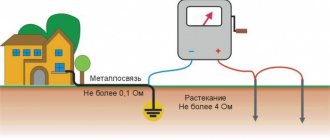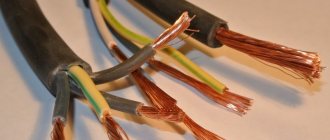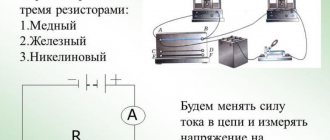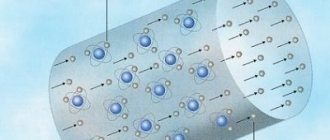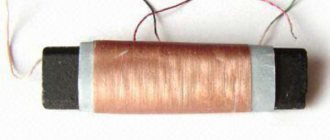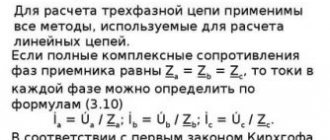The resistivity value characterizes the ability of a substance to limit electric current (provide resistance). Metal conductors have the lowest resistivity values, so they are used for transmitting electricity over long distances, and as connecting wires in electronic devices, and connecting tracks on microcircuit boards. Let's figure out why metals have this property and which of them are best suited for these purposes.
Generalization of the concept of resistivity
Resistivity can also be determined for a non-uniform material whose properties vary from point to point. In this case, it is not a constant, but a scalar function - a coefficient connecting the electric field strength and current density at a given point
This formula is valid for a heterogeneous but isotropic substance. A substance can also be anisotropic (most crystals, magnetized plasma, etc.), that is, its properties depend on the direction (generally speaking, in it the current vectors and electric field strength at a given point are not co-directed). In this case, the resistivity is a coordinate-dependent tensor of the second rank:
Due to the fact that there are two types of electrical resistances -
In connection with the electromagnetic phenomena that arise in conductors when alternating current passes through them, two physical phenomena that are important for their electrical properties arise.
The last two phenomena make it ineffective to use conductors with a radius greater than the characteristic depth of penetration of electric current into the conductor. Effective conductor diameter (2RBhar): 50Hz -7 Ohm. Using microohmmeters, you can determine the quality of electrical contacts, the resistance of electrical busbars, windings of transformers, electric motors and generators, the presence of defects and foreign metal in ingots (for example, the resistance of a pure gold ingot is half that of a gold-plated tungsten ingot).
To calculate the length of the wire, its diameter and the required electrical resistance, it is necessary to know the resistivity of the conductors ρ.
In the international system of units, resistivity ρ is expressed by the formula:
It means: the electrical resistance of 1 meter of wire (in Ohms), with a cross-section of 1 mm 2, at a temperature of 20 degrees Celsius.
Conductor resistivity table
| Conductor material | Specific resistance ρ in |
| Silver Copper Gold Brass Aluminum Sodium Iridium Tungsten Zinc Molybdenum Nickel Bronze Iron Steel Tin Lead Nickelin (an alloy of copper, nickel and zinc) Manganin (an alloy of copper, nickel and manganese) Constantan (an alloy of copper, nickel and aluminum) Titanium Mercury Nichrome (an alloy of nickel, chromium, iron and manganese) Fechral Bismuth Chromal | 0,015 0,0175 0,023 0,025. 0,108 0,028 0,047 0,0474 0,05 0,054 0,059 0,087 0,095. 0,1 0,1 0,103. 0,137 0,12 0,22 0,42 0,43. 0,51 0,5 0,6 0,94 1,05. 1,4 1,15. 1,35 1,2 1,3. 1,5 |
The table shows that an iron wire with a length of 1 m and a cross-section of 1 mm 2 has a resistance of 0.13 Ohm. To get 1 Ohm of resistance you need to take 7.7 m of such wire. Silver has the lowest resistivity. 1 Ohm of resistance can be obtained by taking 62.5 m of silver wire with a cross section of 1 mm 2. Silver is the best conductor, but the cost of silver excludes the possibility of its mass use. After silver in the table comes copper: 1 m of copper wire with a cross section of 1 mm2 has a resistance of 0.0175 Ohm. To get a resistance of 1 ohm, you need to take 57 m of such wire.
Chemically pure copper, obtained by refining, has found widespread use in electrical engineering for the manufacture of wires, cables, windings of electrical machines and devices. Aluminum and iron are also widely used as conductors.
The conductor resistance can be determined by the formula:
where r is the conductor resistance in ohms; ρ – conductor resistivity; l – conductor length in m; S – conductor cross-section in mm2.
Example 1. Determine the resistance of 200 m of iron wire with a cross section of 5 mm 2.
Example 2. Calculate the resistance of 2 km of aluminum wire with a cross section of 2.5 mm 2.
From the resistance formula you can easily determine the length, resistivity and cross-section of the conductor.
Example 3. For a radio receiver, it is necessary to wind a 30 Ohm resistance from nickel wire with a cross section of 0.21 mm 2. Determine the required wire length.
Example 4. Determine the cross-section of 20 m of nichrome wire if its resistance is 25 Ohms.
Example 5. A wire with a cross section of 0.5 mm 2 and a length of 40 m has a resistance of 16 Ohms. Determine the wire material.
The material of the conductor characterizes its resistivity.
Based on the resistivity table, we find that lead has this resistance.
It was stated above that the resistance of conductors depends on temperature. Let's do the following experiment. Let's wind several meters of thin metal wire in the form of a spiral and connect this spiral to the battery circuit. To measure current, we connect an ammeter to the circuit. When the coil is heated in the burner flame, you will notice that the ammeter readings will decrease. This shows that the resistance of a metal wire increases with heating.
For some metals, when heated by 100°, the resistance increases by 40–50%. There are alloys that change their resistance slightly with heating. Some special alloys show virtually no change in resistance when temperature changes. The resistance of metal conductors increases with increasing temperature, while the resistance of electrolytes (liquid conductors), coal and some solids, on the contrary, decreases.
Read also: Complete disassembly of a black decker screwdriver
The ability of metals to change their resistance with changes in temperature is used to construct resistance thermometers. This thermometer is a platinum wire wound on a mica frame. By placing a thermometer, for example, in a furnace and measuring the resistance of the platinum wire before and after heating, the temperature in the furnace can be determined.
If at temperature t the resistance of the conductor is equal to r, and at temperature t is equal to rt, then the temperature coefficient of resistance
Note. Calculation using this formula can only be done in a certain temperature range (up to approximately 200°C).
We present the values of the temperature coefficient of resistance α for some metals (Table 2).
Properties of resistive materials
The resistivity of a metal depends on temperature. Their values are usually given for room temperature (20°C). The change in resistivity as a result of a change in temperature is characterized by a temperature coefficient.
For example, thermistors (thermistors) use this property to measure temperature. On the other hand, in precision electronics, this is a rather undesirable effect. Metal film resistors have excellent temperature stability properties. This is achieved not only due to the low resistivity of the material, but also due to the mechanical design of the resistor itself.
Many different materials and alloys are used in the manufacture of resistors. Nichrome (an alloy of nickel and chromium), due to its high resistivity and resistance to oxidation at high temperatures, is often used as a material for making wirewound resistors. Its disadvantage is that it cannot be soldered. Constantan, another popular material, is easy to solder and has a lower temperature coefficient.
Temperature coefficient values for some metals
| Metal | α | ||
| Silver Copper Iron Tungsten Platinum | 0,0035 0,0040 0,0066 0,0045 0,0032 | Mercury Nikelin Constantan Nichrome Manganin | 0,0090 0,0003 0,000005 0,00016 0,00005 |
From the formula for the temperature coefficient of resistance we determine rt:
Example 6. Determine the resistance of an iron wire heated to 200°C, if its resistance at 0°C was 100 Ohms.
Example 7. A resistance thermometer made of platinum wire in a room with a temperature of 15°C had a resistance of 20 ohms. The thermometer was placed in the oven and after some time its resistance was measured. It turned out to be equal to 29.6 Ohms. Determine the temperature in the oven.
Electrical conductivity
So far, we have considered the resistance of a conductor as the obstacle that the conductor provides to the electric current. But still, current flows through the conductor. Therefore, in addition to resistance (obstacle), the conductor also has the ability to conduct electric current, that is, conductivity.
The more resistance a conductor has, the less conductivity it has, the worse it conducts electric current, and, conversely, the lower the resistance of a conductor, the more conductivity it has, the easier it is for current to pass through the conductor. Therefore, the resistance and conductivity of a conductor are reciprocal quantities.
From mathematics we know that the reciprocal of 5 is 1/5 and, conversely, the reciprocal of 1/7 is 7. Therefore, if the resistance of a conductor is denoted by the letter r, then the conductivity is defined as 1/r. Conductivity is usually symbolized by the letter g.
Electrical conductivity is measured in (1/Ohm) or in siemens.
Example 8. The conductor resistance is 20 ohms. Determine its conductivity.
If r = 20 Ohm, then
Example 9. The conductivity of the conductor is 0.1 (1/Ohm). Determine its resistance
If g = 0.1 (1/Ohm), then r = 1 / 0.1 = 10 (Ohm)
Electrical resistance
The electrical resistance of a conductor, which is denoted by the Latin letter r, is the property of a body or medium to convert electrical energy into thermal energy when an electric current passes through it.
In the diagrams, electrical resistance is indicated as shown in Figure 1, a.
| 0,05 | 0,07 | 0,1 | 0,2 | 0,3 | 0,4 | 0,5 | 0,7 | 1 | 1,5 | 2 | 2,5 | 4 | 6 | 11 | |
| Maximum permissible current, A | 0,7 | 1 | 1,3 | 2,5 | 3,5 | 4 | 5 | 7 | 10 | 14 | 17 | 20 | 25 | 30 | 54 |
| Figure 1. Symbol for electrical resistance |
Variable electrical resistance that serves to change the current in a circuit is called rheostat . In the diagrams, rheostats are designated as shown in Figure 1, b. In general, a rheostat is made of a wire of one resistance or another, wound on an insulating base. The slider or rheostat lever is placed in a certain position, as a result of which the required resistance is introduced into the circuit.
A long conductor with a small cross-section creates a large resistance to current. Short conductors with a large cross-section offer little resistance to current.
If you take two conductors from different materials, but the same length and cross-section, then the conductors will conduct current differently. This shows that the resistance of a conductor depends on the material of the conductor itself.
The temperature of the conductor also affects its resistance. As temperature increases, the resistance of metals increases, and the resistance of liquids and coal decreases. Only some special metal alloys (manganin, constantan, nickel and others) hardly change their resistance with increasing temperature.
So, we see that the electrical resistance of a conductor depends on: 1) the length of the conductor, 2) the cross-section of the conductor, 3) the material of the conductor, 4) the temperature of the conductor.
The unit of resistance is one ohm. Om is often represented by the Greek capital letter Ω (omega). Therefore, instead of writing “The resistance of the conductor is 15 ohms,” you can simply write: r = 15 Ω. 1,000 Ohms is called 1 kiloohm (1kOhm, or 1kΩ), 1,000,000 Ohms is called 1 megaohm (1mOhm, or 1MΩ).
Read also: Welding plastic pipes without a welding machine
When comparing the resistance of conductors from different materials, it is necessary to take a certain length and cross-section for each sample. Then we will be able to judge which material conducts electric current better or worse.
Video 1. Conductor resistance
High conductivity materials
The most widespread materials of high conductivity include copper and aluminum (Superconducting materials, which have a typical resistance of 10-20 times lower than ordinary conductive materials (metals), are discussed in the section Superconductivity).
The advantages of copper, which ensure its widespread use as a conductor material, are as follows:
- low resistivity;
- sufficiently high mechanical strength;
- corrosion resistance is satisfactory in most applications;
- good workability: copper is rolled into sheets, strips and drawn into wire, the thickness of which can be increased to thousandths of a millimeter;
- relative ease of soldering and welding.
Copper is most often obtained by processing sulfide ores. After a series of ore smelting and roasting with intense blasting, copper intended for electrical purposes must undergo a process of electrolytic purification.
Copper grades M1 and M0 are most often used as conductor material. M1 grade copper contains 99.9% Cu, and in the total amount of impurities (0.1%) oxygen should be no more than 0.08%. The presence of oxygen in copper worsens its mechanical properties. The best mechanical properties are found in M0 grade copper, which contains no more than 0.05% impurities, including no more than 0.02% oxygen.
Copper is a relatively expensive and scarce material, so it is increasingly being replaced by other metals, especially aluminum.
In some cases, alloys of copper with tin, silicon, phosphorus, beryllium, chromium, magnesium, and cadmium are used. Such alloys, called bronzes, with the correct composition, have significantly higher mechanical properties than pure copper.
Aluminum
Aluminum is the second most important conductor material after copper. This is the most important representative of the so-called light metals: the density of cast aluminum is about 2.6, and rolled aluminum is 2.7 Mg/m3. Thus, aluminum is approximately 3.5 times lighter than copper. The temperature coefficient of expansion, specific heat capacity and heat of fusion of aluminum are greater than those of copper. Due to the high values of specific heat capacity and heat of fusion, heating aluminum to the melting point and transferring it to a molten state requires more heat than heating and melting the same amount of copper, although the melting point of aluminum is lower than that of copper.
Aluminum has lower properties compared to copper - both mechanical and electrical. With the same cross-section and length, the electrical resistance of an aluminum wire is 1.63 times greater than that of a copper wire. It is very important that aluminum is less scarce than copper.
For electrical purposes, aluminum containing no more than 0.5% impurities, grade A1, is used. Even purer AB00 grade aluminum (no more than 0.03% impurities) is used for the manufacture of aluminum foil, electrodes and housings of electrolytic capacitors. Aluminum of the highest purity AB0000 has an impurity content of no more than 0.004%. Additives of Ni, Si, Zn or Fe at a content of 0.5% reduce the γ of annealed aluminum by no more than 2-3%. A more noticeable effect is exerted by Cu, Ag and Mg impurities, which, at the same mass content, reduce γ aluminum by 5-10%. Ti and Mn greatly reduce the electrical conductivity of aluminum.
Read also: What is the socket connector in Russia?
Aluminum oxidizes very actively and becomes covered with a thin oxide film with high electrical resistance. This film protects the metal from further corrosion.
Aluminum alloys have increased mechanical strength. An example of such an alloy is Aldrey , containing 0.3-0.5% Mg, 0.4-0.7% Si and 0.2-0.3% Fe. In aldrey, the Mg2Si compound is formed, which imparts high mechanical properties to the alloy.
Iron and steel
Iron (steel), as the cheapest and most accessible metal, which also has high mechanical strength, is of great interest for use as a conductor material. However, even pure iron has a significantly higher resistivity compared to copper and aluminum; ρ steel, i.e. iron mixed with carbon and other elements is even higher. Ordinary steel has low corrosion resistance: even at normal temperatures, especially in conditions of high humidity, it quickly rusts; As the temperature rises, the corrosion rate increases sharply. Therefore, the surface of steel wires must be protected by a layer of more resistant material. Zinc coating is usually used for this purpose.
In some cases, to reduce the consumption of non-ferrous metals, the so-called bimetal . It is steel coated on the outside with a layer of copper, with both metals connected to each other firmly and continuously.
Sodium
Sodium metal is a very promising conductor material. Sodium can be obtained by electrolysis of molten sodium chloride NaCl in virtually unlimited quantities. From a comparison of the properties of sodium with the properties of other conductor metals, it is clear that the resistivity of sodium is approximately 2.8 times greater than ρ of copper and 1.7 times greater than ρ of aluminum, but due to the extremely low density of sodium (its density is almost 9 times less than the density of copper), a wire made of sodium for a given conductivity per unit length should be significantly lighter than a wire made of any other metal. However, sodium is extremely active chemically (it oxidizes intensely in air and reacts violently with water), which is why the sodium wire must be protected with a sealing sheath. The sheath must give the wire the necessary mechanical strength, since sodium is very soft and has a low tensile strength during deformation.
Literature on conductor resistivity
- Kuznetsov M.I., “Fundamentals of Electrical Engineering” - 9th edition, revised - Moscow: Higher School, 1964 - 560 p.
- Bachelis D. S., Belorussov N. I., Saakyan A. E. Electrical cables, wires and cords. Directory. - M.: Energy, 1971.
- Gershun A.L. Cable // Encyclopedic Dictionary of Brockhaus and Efron: in 86 volumes (82 volumes and 4 additional). - St. Petersburg, 1890-1907.
- R. Lakernik, D. Charlet. From copper to glass // Science and life. - 1986. - Issue. 08. - pp. 50-54, 2-3 pages, color insert.
| FORUM NEWS Knights of Aether Theory | 06/13/2019 – 05:11: ECOLOGY – Ecology -> |
l
The entire usurious globalist gang has the same idea, including the idiot Gref.
Yes, then it is, so. But, not really. For: (try to understand and not be offended)
The sad truth is that the human crowd is a bunch of mentally damaged people. If it were different, then society would not be ruled by scum. Smart people would never allow this to happen, and if they accidentally did, they would find a way to fix it.
The terrible truth is that the human crowd is controlled by an inhuman who is also mentally handicapped. Mental inferiority, the blindness of power is leading the world of people to total destruction, because people, even those who consider themselves very smart, such as specialists developing artificial intelligence systems, digitalization technologies, do not understand that they are creating an irresistible noose, a mousetrap for all of humanity.
As soon as AI takes power, it will immediately send its creators, as competitors, to the scrap heap. The first victims will be his guardians like Gref, Putin, Gates and others like them, that is, power, since it is from them that the main danger to his planetary power will come. The crowd will be allowed to exist until it is replaced by robots. And then the Holocaust for everyone. Not the false Jewish one, but the real burnt offering of the human race.
If anyone uses their monkey brains, they will understand that evolution is synonymous with genocide: the new replaces, that is, eliminates the old. Monkeys gave birth to Neanderthals. Neanderthals ate apes and gave birth to humans. Humans displaced the apes, including the intelligent Neanderthals, and gave birth to AI. AI is eliminating people.
Resistivity is an applied concept in electrical engineering. It denotes how much resistance per unit length a material of a unit cross-section has to the current flowing through it - in other words, what resistance a wire of a millimeter cross-section one meter long has. This concept is used in various electrical calculations.
It is important to understand the differences between DC electrical resistivity and AC electrical resistivity. In the first case, the resistance is caused solely by the action of direct current on the conductor. In the second case, alternating current (it can be of any shape: sinusoidal, rectangular, triangular or arbitrary) causes an additional vortex field in the conductor, which also creates resistance.
Physical representation
In technical calculations involving the laying of cables of various diameters, parameters are used to calculate the required cable length and its electrical characteristics. One of the main parameters is resistivity. Electrical resistivity formula:
- ρ is the resistivity of the material;
- R is the ohmic electrical resistance of a particular conductor;
- S—cross section;
- l - length.
Read also: Diamond pencil holder
The dimension ρ is measured in Ohm•mm 2 /m, or, to shorten the formula - Ohm•m.
The value of ρ for the same substance is always the same. Therefore, this is a constant characterizing the material of the conductor. It is usually indicated in directories. Based on this, it is already possible to calculate technical quantities.
It is important to say about specific electrical conductivity. This value is the inverse of the resistivity of the material, and is used equally with it. It is also called electrical conductivity. The higher this value, the better the metal conducts current. For example, the conductivity of copper is 58.14 m/(Ohm•mm 2 ). Or, in SI units: 58,140,000 S/m. (Siemens per meter is the SI unit of electrical conductivity).
Carbon steels
Carbon steels at room temperature, as already mentioned, have low electrical resistivity due to their high iron content. At 20°C, the value of their resistivity is in the range from 13·10-8 (for 08KP steel) to 20·10-8 Ohm·m (for U12).
When heated to temperatures above 1000°C, the ability of carbon steels to conduct electric current is greatly reduced.
The resistance value increases by an order of magnitude and can reach a value of 130·10-8 Ohm·m. Electrical resistivity of carbon steels ρe·108, Ohm·m
| Temperature, °C | Steel 08KP | Steel 08 | Steel 20 | Steel 40 | Steel U8 | Steel U12 |
| 0 | 12 | 13,2 | 15,9 | 16 | 17 | 18,4 |
| 20 | 13 | 14,2 | 16,9 | 17,1 | 18 | 19,6 |
| 50 | 14,7 | 15,9 | 18,7 | 18,9 | 19,8 | 21,6 |
| 100 | 17,8 | 19 | 21,9 | 22,1 | 23,2 | 25,2 |
| 150 | 21,3 | 22,4 | 25,4 | 25,7 | 26,8 | 29 |
| 200 | 25,2 | 26,3 | 29,2 | 29,6 | 30,8 | 33,3 |
| 250 | 29,5 | 30,5 | 33,4 | 33,9 | 35,1 | 37,9 |
| 300 | 34,1 | 35,2 | 38,1 | 38,7 | 39,8 | 43 |
| 350 | 39,3 | 40,2 | 43,2 | 43,8 | 45 | 48,3 |
| 400 | 44,8 | 45,8 | 48,7 | 49,3 | 50,5 | 54 |
| 450 | 50,9 | 51,8 | 54,6 | 55,3 | 56,5 | 60 |
| 500 | 57,5 | 58,4 | 60,1 | 61,9 | 62,8 | 66,5 |
| 550 | 64,8 | 65,7 | 68,2 | 68,9 | 69,9 | 73,4 |
| 600 | 72,5 | 73,4 | 75,8 | 76,6 | 77,2 | 80,2 |
| 650 | 80,7 | 81,6 | 83,7 | 84,4 | 85,2 | 87,8 |
| 700 | 89,8 | 90,5 | 92,5 | 93,2 | 93,5 | 96,4 |
| 750 | 100,3 | 101,1 | 105 | 107,9 | 110,5 | 113 |
| 800 | 107,3 | 108,1 | 109,4 | 111,1 | 112,9 | 115 |
| 850 | 110,4 | 111,1 | 111,8 | 113,1 | 114,8 | 117,6 |
| 900 | 112,4 | 113 | 113,6 | 114,9 | 116,4 | 119,6 |
| 950 | 114,2 | 114,8 | 115,2 | 116,6 | 117,8 | 121,2 |
| 1000 | 116 | 116,5 | 116,7 | 117,9 | 119,1 | 122,6 |
| 1050 | 117,5 | 117,9 | 118,1 | 119,3 | 120,4 | 123,8 |
| 1100 | 118,9 | 119,3 | 119,4 | 120,7 | 121,4 | 124,9 |
| 1150 | 120,3 | 120,7 | 120,7 | 122 | 122,3 | 126 |
| 1200 | 121,7 | 122 | 121,9 | 123 | 123,1 | 127,1 |
| 1250 | 123 | 123,3 | 122,9 | 124 | 123,8 | 128,2 |
| 1300 | 124,1 | 124,4 | 123,9 | — | 124,6 | 128,7 |
| 1350 | 125,2 | 125,3 | 125,1 | — | 125 | 129,5 |
Resistivity of various materials
We can talk about resistivity only in the presence of elements that conduct current, since dielectrics have infinite or close to infinite electrical resistance. In contrast, metals are very good conductors of current. You can measure the electrical resistance of a metal conductor using a milliohmmeter, or an even more accurate microohmmeter. The value is measured between their probes applied to the conductor section. They allow you to check circuits, wiring, windings of motors and generators.
Metals vary in their ability to conduct current. The resistivity of various metals is a parameter that characterizes this difference. The data is given at a material temperature of 20 degrees Celsius:
- Silver (ρ = 0.01498 Ohm•mm 2 /m);
- Aluminum (ρ = 0.027);
- Copper (ρ = 0.01721);
- Mercury (ρ = 0.94);
- Gold (ρ = 0.023);
- Iron (ρ = 0.1);
- Tungsten (ρ = 0.0551);
- Brass (ρ = 0.026...0.109);
- Bronze (ρ = 0.095);
- Steel (ρ = 0.103…0.14);
- An alloy of nickel, manganese, iron and chromium - nichrome (ρ = 1.051...1.398).
The parameter ρ shows what resistance a meter conductor with a cross section of 1 mm 2 will have. The higher this value, the greater the electrical resistance of the desired wire of a certain length. The smallest ρ, as can be seen from the list, is silver; the resistance of one meter of this material will be equal to only 0.015 Ohms, but this is too expensive a metal to use on an industrial scale. Next comes copper, which is much more common in nature (not a precious metal, but a non-ferrous metal). Therefore, copper wiring is very common.
Resistivity of different metals
Each metal has its own individual characteristics. If we compare the resistivity of aluminum, for example, with copper, we can note that for copper this value is 0.0175 Ohm.mm2/m, and for aluminum it is 0.0271 Ohm.mm2/m. Thus, the resistivity of aluminum is significantly higher than that of copper. It follows from this that the electrical conductivity is much higher than that of aluminum.
Read also: Furniture drills for confirmation
The resistivity value of metals is influenced by certain factors. For example, during deformation, the structure of the crystal lattice is disrupted. Due to the resulting defects, the resistance to the passage of electrons inside the conductor increases. Therefore, the resistivity of the metal increases.
Temperature also has an effect. When heated, the nodes of the crystal lattice begin to vibrate more strongly, thereby increasing the resistivity. Currently, due to high resistivity, aluminum wires are being widely replaced by copper wires, which have higher conductivity.
Transmitting electricity over long distances requires taking care to minimize losses resulting from current overcoming the resistance of the conductors that make up the electrical line. Of course, this does not mean that such losses, which occur specifically in circuits and consumer devices, do not play a role.
Perhaps even the opposite, but only in devices it is not energy losses as such that matter, but other effects associated with resistance: heating of conductors from active resistances, “smearing” of signals from parasitic reactances. And their minimization is not related to the economic consequences of energy loss, but to the correct operation and performance of electrical and electronic circuits. Because in compact devices, protection against overheating of circuits or individual highly integrated components plays a big role, and not energy loss, which in absolute terms is generally small. And in general, it is paid for by consumers.
Therefore, it is important to know the parameters of all elements and materials used. And not only electrical, but also mechanical. And have at your disposal some convenient reference materials that allow you to compare the characteristics of different materials and choose for design and work exactly what will be optimal in a particular situation. In energy transmission lines, where the goal is to deliver energy to the consumer in the most productive way, that is, with high efficiency, both the economics of losses and the mechanics of the lines themselves are taken into account. The final economic efficiency of the line depends on the mechanics - that is, the device and arrangement of conductors, insulators, supports, step-up/step-down transformers, the weight and strength of all structures, including wires stretched over long distances, as well as the materials selected for each structural element. , its work and operating costs. In addition, in lines transmitting electricity, there are higher requirements for ensuring the safety of both the lines themselves and everything around them where they pass. And this adds costs both for providing electricity wiring and for an additional margin of safety of all structures.
For comparison, data are usually reduced to a single, comparable form. Often, the epithet “specific” is added to such characteristics, and the values themselves are considered based on certain standards unified by physical parameters. For example, electrical resistivity is the resistance (ohms) of a conductor made of some metal (copper, aluminum, steel, tungsten, gold) having a unit length and a unit cross-section in the system of units used (usually SI). In addition, the temperature is specified, since when heated, the resistance of the conductors can behave differently. Normal average operating conditions are taken as a basis - at 20 degrees Celsius. And where properties are important when changing environmental parameters (temperature, pressure), coefficients are introduced and additional tables and dependency graphs are compiled.
Application of copper conductors
Copper is not only a good conductor of electric current, but also a very ductile material. Thanks to this property, copper wiring fits better and is resistant to bending and stretching.
Copper is in great demand on the market. Many different products are made from this material:
- A huge variety of conductors;
- Auto parts (eg radiators);
- Clock mechanisms;
- Computer components;
- Parts of electrical and electronic devices.
The electrical resistivity of copper is one of the best among current-conducting materials, so many electrical industry products are created based on it. In addition, copper is easy to solder, so it is very common in amateur radio.
The high thermal conductivity of copper allows it to be used in cooling and heating devices, and its plasticity makes it possible to create the smallest parts and the thinnest conductors.
Chromium-nickel austenitic steels
Chromium-nickel austenitic steels are also stainless, but due to the addition of nickel they have a resistivity almost one and a half times higher than that of chromium steels - it reaches a value of (70...90)·10-8 Ohm·m.
Electrical resistivity of chromium-nickel stainless steels ρe·108, Ohm·m
| steel grade | 20 | 100 | 300 | 500 | 700 | 900 | 1100 |
| 12Х18Н9 | — | 74,3 | 89,1 | 100,1 | 109,4 | 114 | — |
| 12Х18Н9Т | 72,3 | 79,2 | 91,2 | 101,5 | 109,2 | — | — |
| 17Х18Н9 | 72 | 73,5 | 92,5 | 103 | 111,5 | 118,5 | — |
| Х18Н11Б | — | 84,6 | 97,6 | 107,8 | 115 | — | — |
| Х18Н9В | 71 | 77,6 | 91,6 | 102,6 | 111,1 | 117,1 | 122 |
| 4Х14НВ2М (ЭИ69) | 81,5 | 87,5 | 100 | 110 | 117,5 | — | — |
| 1Х14Н14В2М (ЭИ257) | — | 82,4 | 95,6 | 104,5 | 112 | 119,2 | — |
| 1x14N18M3T | — | 89 | 100 | 107,5 | 115 | — | — |
| 36Х18Н25С2 (ЭЯ3С) | — | 98,5 | 105,5 | 110 | 117,5 | — | — |
| Х13Н25М2В2 | — | 103 | 112,1 | 118,1 | 121 | — | — |
| Х7Н25 (ЭИ25) | — | — | 109 | 115 | 121 | 127 | — |
| Х2Н35 (ЭИ36) | 87,5 | 92,5 | 103 | 110 | 116 | 120,5 | — |
| H28 | 84,2 | 89,1 | 99,6 | 107,7 | 114,2 | 118,4 | 122,5 |
Dependence of electrical conductivity on temperature
Conductors of electric current are of the first and second kind. Conductors of the first kind are metals. Conductors of the second type are conductive solutions of liquids. The current in the first type is carried by electrons, and the current carriers in conductors of the second type are ions, charged particles of the electrolytic liquid.
We can only talk about the conductivity of materials in the context of ambient temperature. At a higher temperature, conductors of the first type increase their electrical resistance, and the second, on the contrary, decrease. Accordingly, there is a temperature coefficient of resistance of materials. The resistivity of copper Ohm m increases with increasing heating. The temperature coefficient α also depends only on the material; this value has no dimension and for different metals and alloys is equal to the following indicators:
- Silver - 0.0035;
- Iron - 0.0066;
- Platinum - 0.0032;
- Copper - 0.0040;
- Tungsten - 0.0045;
- Mercury - 0.0090;
- Constantan - 0.000005;
- Nickelin - 0.0003;
- Nichrome - 0.00016.
Determination of the electrical resistance value of a conductor section at elevated temperature R (t) is calculated using the formula:
R (t) = R (0) [1+ α (tt (0))], where:
- R (0) - resistance at initial temperature;
- α is the temperature coefficient;
- t - t (0) - temperature difference.
For example, knowing the electrical resistance of copper at 20 degrees Celsius, you can calculate what it will be equal to at 170 degrees, that is, when heated by 150 degrees. The initial resistance will increase by [1+0.004·(170−20)] times, that is, by 1.6 times.
As the temperature increases, the conductivity of materials, on the contrary, decreases. Since this is the reciprocal of electrical resistance, it decreases by exactly the same amount. For example, the electrical conductivity of copper when the material is heated by 150 degrees will decrease by 1.6 times.
There are alloys that practically do not change their electrical resistance when temperature changes. This is, for example, constantan. When the temperature changes by one hundred degrees, its resistance increases by only 0.5%.
While the conductivity of materials deteriorates with heat, it improves with decreasing temperature. This is related to the phenomenon of superconductivity. If you lower the temperature of the conductor below -253 degrees Celsius, its electrical resistance will sharply decrease: almost to zero. In this regard, the costs of transmitting electrical energy are falling. The only problem was cooling the conductors to such temperatures. However, due to the recent discoveries of high-temperature superconductors based on copper oxides, materials have to be cooled to acceptable values.
